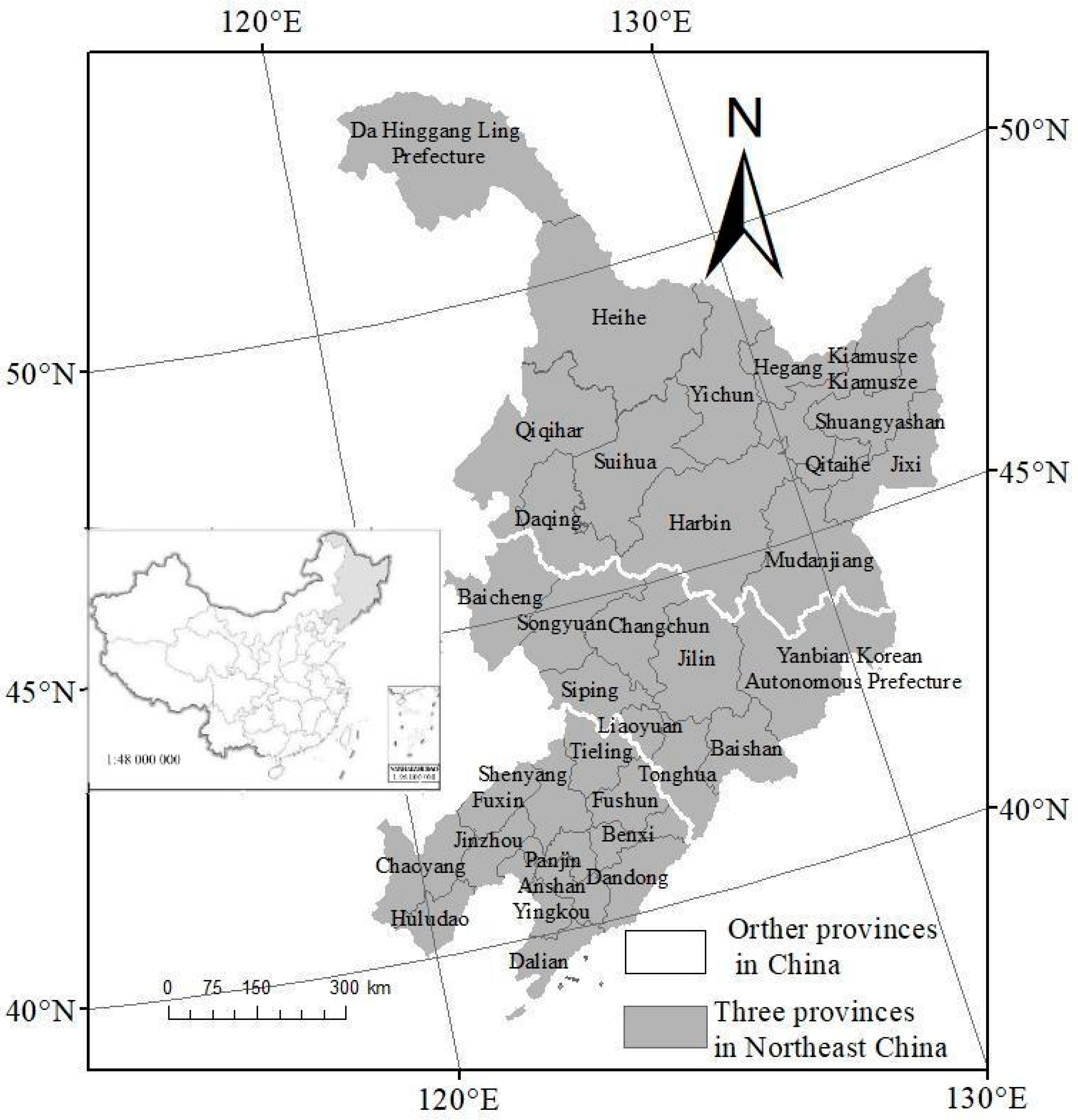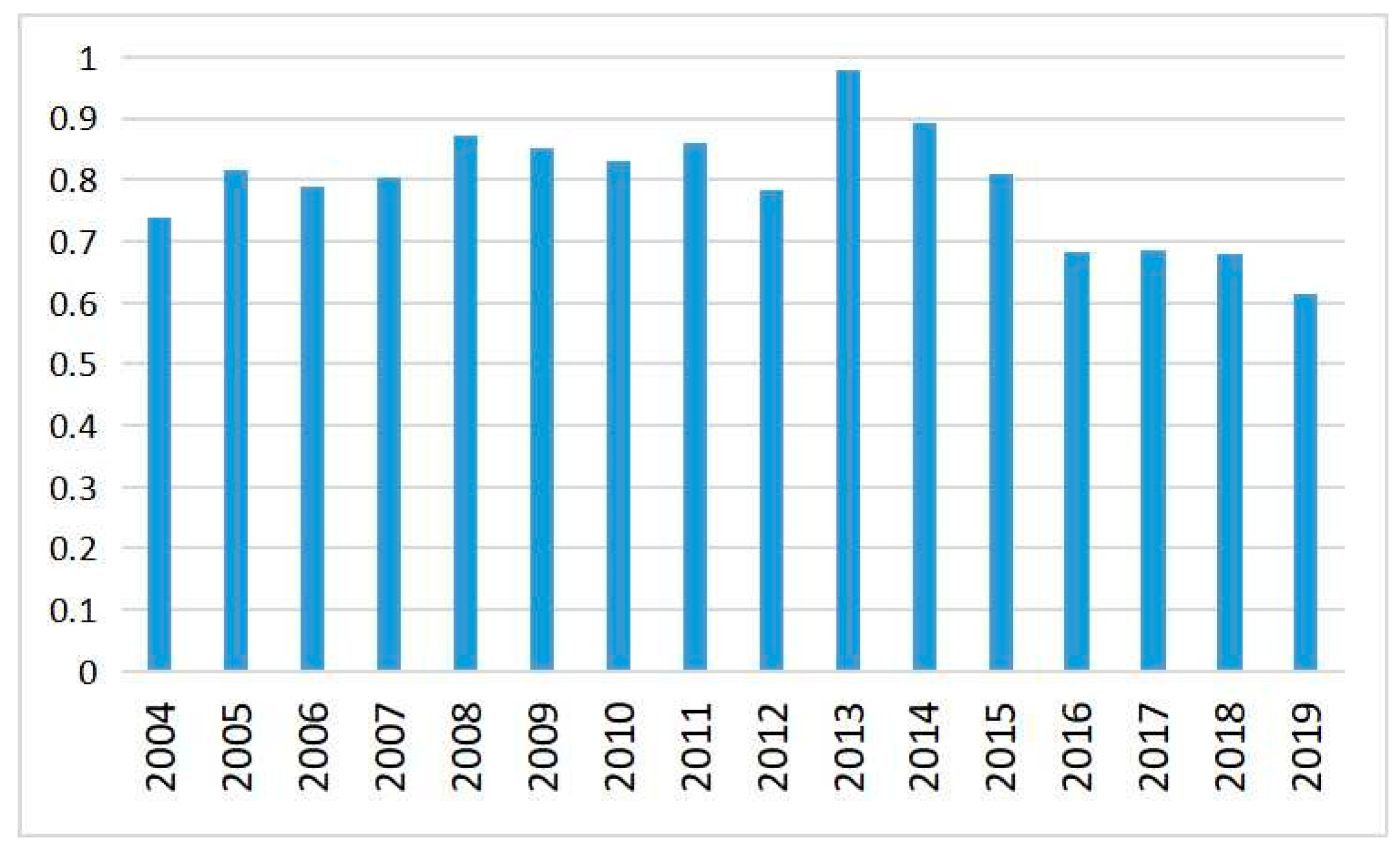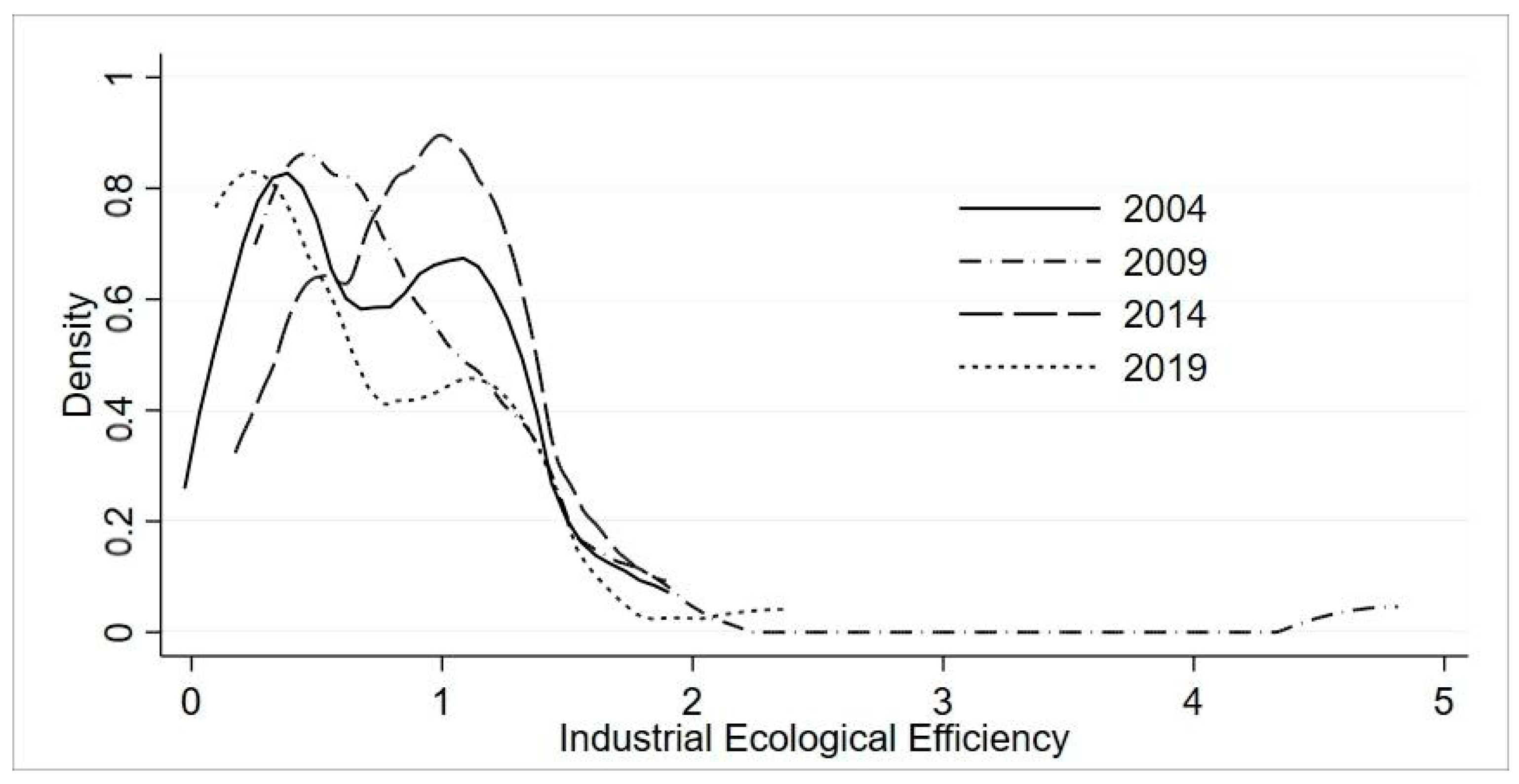Spatiotemporal Patterns and Influencing Factors of Industrial Ecological Efficiency in Northeast China
Abstract
:1. Introduction
2. Research Area and Research Method
2.1. Study Area Selection
2.2. Research Data Indicators
2.2.1. Industrial Ecological Efficiency Measurement Index
2.2.2. Analysis Index of the Driving Mechanism of the Spatiotemporal Evolution
2.3. Research Methods
2.3.1. Super-SBM Model
2.3.2. Spatial Autocorrelation
2.3.3. Geographically and Temporally Weighted Regression
3. Results of the Study
3.1. Evolution of the Spatiotemporal Patterns of Industrial Ecological Efficiency in Northeast China
Time Sequence Characteristics of Industrial Ecological Efficiency
3.2. Spatial Correlation Change in Industrial Ecological Efficiency in Northeast China
3.3. Spatiotemporal Differentiation of Factors Influencing Industrial Ecological Efficiency in Northeast China
3.3.1. Determination of the Main Influencing Factors
3.3.2. Spatiotemporal Differentiation of the Main Influencing Factors
4. Discussion
- (1).
- The analysis of the spatiotemporal differentiation characteristics of regional industrial ecological efficiency and its influencing factors is an important entry point for the current field of regional geography to pay attention to regional sustainable development. However, the existing research does not cover all types of industrial areas, and the analysis of influencing factors is relatively simple. This study selected Northeast China, which is in the revitalization stage, as the empirical research region. Based on the characteristics of its old industrial base, this study analyzed the overall change law of industrial ecological efficiency, the spatiotemporal differentiation characteristics, and the main influencing factors behind it in 34 prefecture-level cities. The research ideas and methods can provide a reference for other types of related research at the regional level and also provide practical guidance for the improvement in industrial ecological efficiency and sustainable development in Northeast China.
- (2).
- Based on the space-time pattern of industrial ecological efficiency and the space-time changes of influencing factors in Northeast China, this study had obvious policy implications. First, in the present stage, the government’s environmental governance capacity in Northeast China is weak, and the impact on improving industrial ecological efficiency is not obvious. In the future, we should actively promote bilateral or multilateral government cooperation between internal cities, break the shackles of “information island” and “policy island,” establish a long-term mechanism for regional collaborative governance, and gradually narrow the internal gap. Second, the impact of the economic extroverted degree and the government governance capacity on the industrial ecological efficiency in Northeast China is misplaced in space. This shows that, in the process of introducing foreign investment, Northeast China should reasonably plan the industrial structure, standardize the land-use mode, delimit the “restricted development” and “prohibited development” areas, improve the access audit mechanism of high-pollution and high-energy-consumption industries, and encourage and support the development of clean and sustainable industries. Third, Northeast China should formulate differentiated strategies according to different situations of internal industrial agglomeration. For the key industrial bearing space such as urban agglomerations of Harbin–Changchun and central and southern parts of Liaoning in the middle of Northeast China, the internal pattern of industrial agglomeration should be diluted, and the evolution from “single core” to “multi-core” pattern should be accelerated. This can promote the transformation from collective industrial agglomeration into professional industrial agglomeration, improve the relevance of agglomeration industries, and enhance regional competitiveness. For the northern, eastern, and western cities, it is necessary to focus on cultivating professional industrial agglomeration areas.
- (3).
- This study was carried out in prefecture-level cities in Northeast China. However, the pattern and influencing factors of industrial ecological efficiency in Northeast China still need to be examined on more refined county and township scales. At the same time, this study selected only five influencing factors to analyze their influence on industrial ecological efficiency in Northeast China. Considering the actual situation, new influencing factors can also be added for the analysis. Moreover, the evolution of the spatiotemporal patterns of the industrial ecological efficiency still needs continuous observation and research with the promotion of the second revitalization of the old industrial base in Northeast China.
5. Conclusions
- (1).
- The temporal variation in industrial ecological efficiency in Northeast China is characterized by low-level fluctuation and decline. From 2004 to 2019, Northeast China experienced the development process of “recession–revitalization–economic downturn–secondary revitalization”. However, its industrial structure, dominated by traditional industries, still did not change significantly, and the industrial ecological efficiency also showed a fluctuating downward trend. Among the 34 cities in Northeast China, the number of cities with high-level industrial ecological efficiency decreased, and the number of cities with low-level industrial ecological efficiency increased. The pattern of development level among cities changed from “small gap at a high level” to “large gap at a low level”.
- (2).
- The spatial pattern of industrial ecological efficiency in Northeast China is mainly reflected in east–west and south–north differences. In 2004, the gap of industrial ecological efficiency in Northeast China was obvious in the east–west direction, with no significant difference in the north–south direction. In 2019, the spatial differences in the east–west direction decreased significantly, and that in the north–south direction expanded significantly. Specifically, the northern part of Heilongjiang province and the central and western parts of Jilin province showed a “block” distribution of high industrial ecological efficiency, while the central and southern parts of Liaoning province and the eastern part of Heilongjiang province showed a “block” distribution of low industrial ecological efficiency. Since 2017, the industrial ecological efficiency of various cities in Northeast China began to have a stable spatial autocorrelation feature. L-H and L-L cluster areas had the largest number of cities. The former were mainly distributed in the eastern Heilongjiang province and the latter in central and southern Liaoning. H-H cluster areas were mainly located in northern Heilongjiang province and western Jilin province, while H-L cluster areas were mainly in the central Jilin province and the western coast of Liaoning.
- (3).
- The spatial and temporal patterns of industrial ecological efficiency in Northeast China were affected by multiple factors, and the influence degree of each influencing factor for different cities in the region was also different. As the regional economic transformation was still in the exploratory stage, the impact of the economy on industrial ecological efficiency was not reflected. The level of science and technology input, government governance ability, and industrial agglomeration intensity had a positive effect on industrial ecological efficiency. Although the influence of economic extroverted degree was not strong, it showed a negative effect. Different factors had different effects on the industrial ecological efficiency of cities in Northeast China. The effect of science and technology input and industrial agglomeration intensity on improving ecological efficiency in central Northeast China was relatively obvious. The influence pattern of economic extroversion changed from “Liaoning > Jilin > Heilongjiang” to “Jilin > Heilongjiang > Liaoning.” The government’s environmental regulation focused more on reducing the environmental pollution caused by the industrial development of key ecological protection areas and ecologically fragile areas, such as the northern, western, and southern regions of Northeast China.
Author Contributions
Funding
Institutional Review Board Statement
Informed Consent Statement
Data Availability Statement
Acknowledgments
Conflicts of Interest
References
- Li, B.G.; Hu, Z.Q.; Miao, C.H.; Zhang, B.F.; Kang, W. Spatial differentiation and influencing factors of industrial eco-efficiency in the Yellow River Basin. Geogr. Res. 2021, 40, 2156–2169. (In Chinese) [Google Scholar]
- Guo, F.Y.; Gao, S.Q.; Tong, L.J.; Ren, J.M. Spatiotemporal evolution characteristics and influencing factors of green development efficiency in the Yellow River Basin. Geogr. Res. 2022, 41, 167–180. (In Chinese) [Google Scholar]
- Guo, F.Y.; Tong, L.J.; Qiu, F.D.; Li, Y.M. Space and temporal differentiation characteristics and influencing factors of green development in the Yellow River Basin. Acta Geogr. Sin. 2021, 76, 726–739. (In Chinese) [Google Scholar]
- Lu, C.; Ji, W.; Hou, M.; Ma, T.; Mao, J. Evaluation of efficiency and resilience of agricultural water resources system in the Yellow River Basin, China. Agric. Water Manag. 2022, 266, 107605. [Google Scholar] [CrossRef]
- Lu, C.; Pan, X.; Chen, X.; Mao, J.; Pang, J.; Xue, B. Modeling of Waste Flow in Industrial Symbiosis System at City-Region Level: A Case Study of Jinchang, China. Sustainability 2021, 13, 466. [Google Scholar] [CrossRef]
- Neto, J.Q.F.; Walther, G.; Bloemhof, J.; van Nunen, J.; Spengler, T. A methodology for assessing eco-efficiency in logistics networks. Eur. J. Oper. Res. 2009, 193, 670–682. [Google Scholar] [CrossRef] [Green Version]
- Höh, H.; Schoer, K.; Seibel, S. Eco-efficiency indicators in German Environmental Economic Accounting. Stat. J. U. N. Econ. Comm. Eur. 2002, 19, 41–52. [Google Scholar] [CrossRef]
- Kuosmanen, T.; Kortelainen, M. Measuring Eco-efficiency of Production with Data Envelopment Analysis. J. Ind. Ecol. 2005, 9, 59–72. [Google Scholar] [CrossRef]
- Picazo-Tadeo, A.J.; Beltrán-Esteve, M.; Gómez-Limón, J.A. Assessing eco-efficiency with directional distance functions. Eur. J. Oper. Res. 2012, 220, 798–809. [Google Scholar] [CrossRef]
- Ma, S.; Hu, S.; Chen, D.; Zhu, B. A case study of a phosphorus chemical firm’s application of resource efficiency and eco-efficiency in industrial metabolism under circular economy. J. Clean. Prod. 2015, 87, 839–849. [Google Scholar] [CrossRef]
- Stergiou, E.; Kounetas, K.E. Eco-efficiency convergence and technology spillovers of European industries. J. Environ. Manag. 2021, 283, 111972. [Google Scholar] [CrossRef] [PubMed]
- Benz, D. Economic growth vs. eco-efficiency of Russian industrial regions. E3S Web Conf. 2021, 258, 06016. [Google Scholar] [CrossRef]
- Zurano-Cervelló, P.; Pozo, C.; Mateo-Sanz, J.M.; Jiménez, L.; Guillén-Gosálbez, G. Eco-efficiency assessment of EU manufacturing sectors combining input-output tables and data envelopment analysis following production and consumption-based accounting approaches. J. Clean. Prod. 2018, 174, 1161–1189. [Google Scholar] [CrossRef]
- Özkan, F.; Özkan, O.; Koubaa, A. Eco-efficiency of the world cement industry and innovations: Panel causality data analysis. Int. J. Glob. Warm. 2013, 5, 179–196. [Google Scholar] [CrossRef]
- Tang, Z.; Sun, G.; Fu, M.; Wen, C.; Plenković-Moraj, A. Research on the Industrial Energy Eco-Efficiency Evolution Characteristics of the Yangtze River Economic Belt in the Temporal and Spatial Dimension, China. Int. J. Environ. Res. Public Health 2019, 17, 268. [Google Scholar] [CrossRef] [Green Version]
- Shao, L.; Yu, X.; Feng, C. Evaluating the eco-efficiency of China’s industrial sectors: A two-stage network data envelopment analysis. J. Environ. Manag. 2019, 247, 551–560. [Google Scholar] [CrossRef]
- Zhang, J.; Liu, Y.; Chang, Y.; Zhang, L. Industrial eco-efficiency in China: A provincial quantification using three-stage data envelopment analysis. J. Clean. Prod. 2017, 143, 238–249. [Google Scholar] [CrossRef]
- Guo, L.; Xu, S.Q. Industrial eco-efficiency based on super-efficiency DEA: A case study of six central provinces from 2003 to 2013. Econ. Geogr. 2016, 36, 116–121+58. (In Chinese) [Google Scholar] [CrossRef]
- Dai, Z.; Guo, L.; Jiang, Z. Study on the industrial Eco-Efficiency in East China based on the Super Efficiency DEA Model: An example of the 2003–2013 panel data. Appl. Econ. 2016, 48, 5779–5785. [Google Scholar] [CrossRef]
- Xiao, Q.L.; Xiao, L.M. The spillover effect of urban ecological governance efficiency from the perspective of residents’ well-being: A case study of the Yangtze River Delta Urban agglomeration. Areal Res. Dev. 2021, 40, 149–155. (In Chinese) [Google Scholar]
- Liu, J.; Liu, X.M.; An, K.K.; Hou, J.J. Study on Spatial-Temporal Variation and Spatial Effect of Tourism Environmental Carrying Capacity in The Yangtze River Delta. Resour. Environ. Yangtze River Basin 2021, 1–17. (In Chinese). Available online: https://kns.cnki.net/kcms/detail/42.1320.X.20211216.1826.002.html (accessed on 8 June 2022).
- Zhang, H.; Chen, Y.H. Research on spatial-temporal evolution and spatial spillover effect of public cultural service of provincial books in China. Econ. Geogr. 2021, 41, 149–156. (In Chinese) [Google Scholar] [CrossRef]
- Tong, Y.; Lui, H.M.; Ma, Y.; Liu, J.; Zhang, R. The impact of Tourism economy on urban green development and its spatial spillover effect in China. Acta Geogr. Sin. 2021, 76, 2504–2521. (In Chinese) [Google Scholar]
- Shi, Y.; Liu, J.; Shi, H.; Li, H.; Li, Q. The ecosystem service value as a new eco-efficiency indicator for industrial parks. J. Clean. Prod. 2017, 164, 597–605. [Google Scholar] [CrossRef]
- Zhang, X.L.; Qiu, F.D.; Tan, J.T.; Wan, C.J. Spatial-temporal differentiation of industrial eco-efficiency and its influencing factors in China. Sci. Geogr. Sin. 2020, 40, 335–343. (In Chinese) [Google Scholar] [CrossRef]
- Lu, C.P.; Liu, Z.L.; Liu, Y.P.; Mao, J.H. Spatial-Temporal Patterns and Influencing Factors of Industrial Ecologization in the Yellow River Basin. Chin. J. Ecol. 2022, 41, 1–13. Available online: https://kns.cnki.net/kcms/detail/detail.aspx?dbcode=CJFD&dbname=CJFDAUTO&filename=STXZ202207012&uniplatform=NZKPT&v=YXAQ5TazdnWKQkPHc_GRQrnLAd0Rp58_7ldHV6at1UqFaees4scZmIROtKBNWn2m (accessed on 8 June 2022).
- Zhang, R.J.; Dong, H.Z. Spatial-temporal evolution and influencing factors of industrial eco-efficiency in China based on provincial scale. Econ. Geogr. 2020, 40, 124–132+173. (In Chinese) [Google Scholar] [CrossRef]
- Huang, H.P.; Li, Y.L.; Wang, Z.P. Spatial-temporal evolution and influencing factors of industrial land eco-efficiency in Provincial cities of China based on Super-SBM model. Acta Ecol. Sin. 2020, 40, 100–111. (In Chinese) [Google Scholar]
- Li, C.Y.; Zhang, S.Q.; Zhang, W. Spatial distribution and influencing factors of provincial industrial eco-efficiency in China. Sci. Geogr. Sin. 2018, 38, 1970–1978. (In Chinese) [Google Scholar] [CrossRef]
- Wu, M. Measurement of Regional Industrial Ecological Efficiency in China and an Analysis of Its Influencing Factors. J. World Econ. Res. 2020, 9, 43–50. [Google Scholar] [CrossRef]
- Ma, Z.; Li, C.; Zhang, J. Understanding Urban Shrinkage from a Regional Perspective: Case Study of Northeast China. J. Urban Plan. Dev. 2020, 146, 05020025. [Google Scholar] [CrossRef]
- Barra, C.; Zotti, R. Investigating the non-linearity between national income and environmental pollution: International evidence of Kuznets curve. Environ. Econ. Policy Stud. 2017, 20, 179–210. [Google Scholar] [CrossRef]
- Panayotou, T. Demystifying the environmental Kuznets curve: Turning a black box into a policy tool. Environ. Dev. Econ. 1997, 2, 465–484. [Google Scholar] [CrossRef] [Green Version]
- Elhorst, J.P. Applied Spatial Econometrics: Raising the Bar. Spat. Econ. Anal. 2010, 5, 9–28. [Google Scholar] [CrossRef]
- Lesage, J.; Pace, R.K. Introduction to Spatial Econometrics; Chapman and Hall/CRC: Boca Raton, FL, USA, 2009; ISBN 978-1-4200-6424-7. [Google Scholar]
- Li, H.; Fang, K.; Yang, W.; Wang, D.; Hong, X. Regional environmental efficiency evaluation in China: Analysis based on the Super-SBM model with undesirable outputs. Math. Comput. Model. 2013, 58, 1018–1031. [Google Scholar] [CrossRef]
- Feng, M.; Li, X. Evaluating the efficiency of industrial environmental regulation in China:A three-stage data envelopment analysis approach. J. Clean. Prod. 2019, 242, 118535. [Google Scholar] [CrossRef]
- Wu, J.; Li, M.; Zhu, Q.; Zhou, Z.; Liang, L. Energy and environmental efficiency measurement of China’s industrial sectors: A DEA model with non-homogeneous inputs and outputs. Energy Econ. 2018, 78, 468–480. [Google Scholar] [CrossRef]
- Hao, Y.; Liu, Y.-M. The influential factors of urban PM2.5 concentrations in China: A spatial econometric analysis. J. Clean. Prod. 2016, 112, 1443–1453. [Google Scholar] [CrossRef]
- Djuraidah, A.; Djalihu, H.; Soleh, A.M. Geographically and Temporally Weighted Autoregressive to Modeling the Levels of Poverty Population in Java in 2012–2018. Int. J. Sci. Basic Appl. Res. (IJSBAR) 2020, 54, 55–67. [Google Scholar] [CrossRef]










| Level 1 Indicators | Level 2 Indicators | Level 3 Indicators |
|---|---|---|
| Investment index | Environmental input | Discharge of industrial wastewater (10,000 t) |
| Industrial soot emission (t) | ||
| Industrial sulfur dioxide emissions (t) | ||
| Funding | Industrial fixed assets (CNY 10,000) | |
| Manpower input | Industrial employees (10,000 people) | |
| Resource input | Industrial water use (10,000 t) | |
| Industrial electricity consumption (10,000 kW h) | ||
| Output index | Economic output | Industrial GDP (CNY 10,000) |
| Influencing Factor | Agent Variable | Measurement Method |
|---|---|---|
| Economic development level | Per capita GDP | Organized from China Urban Statistical Yearbook |
| Industrial agglomeration intensity | Location quotient | Proportion of regional industrial output in regional GDP/the proportion of national industrial output in national GDP |
| Science and technology input | Proportion of the expenditure on science, technology, and education | Science, technology, and education expenditure/GDP |
| Economic extroverted degree | Economic extroversion | Actual utilized foreign capital/GDP |
| Government governance | Industry SO2 processing rate | Industry SO2 production volume/industrial SO2 handling capacity |
| Year | Moran’s | Z-Score | p-Value |
|---|---|---|---|
| 2003 | 0.075811 | 1.355522 | 0.175251 |
| 2004 | 0.055701 | 0.962019 | 0.336040 |
| 2005 | 0.101121 | 1.502341 | 0.133009 |
| 2006 | 0.109344 | 1.562383 | 0.118198 |
| 2007 | 0.104740 | 1.513525 | 0.130146 |
| 2008 | 0.092230 | 1.391958 | 0.163935 |
| 2009 | −0.026962 | 0.050239 | 0.959932 |
| 2010 | −0.007317 | 0.293490 | 0.769147 |
| 2011 | 0.151586 | 2.040306 | 0.041320 |
| 2012 | 0.037969 | 0.770232 | 0.441162 |
| 2013 | 0.024260 | 0.633757 | 0.526240 |
| 2014 | 0.289983 | 3.688333 | 0.000226 |
| 2015 | −0.000783 | 0.335593 | 0.737178 |
| 2016 | 0.015897 | 0.515338 | 0.606317 |
| 2017 | 0.193304 | 2.705608 | 0.006818 |
| 2018 | 0.218529 | 2.911985 | 0.003591 |
| 2019 | 0.155126 | 2.142546 | 0.032150 |
Publisher’s Note: MDPI stays neutral with regard to jurisdictional claims in published maps and institutional affiliations. |
© 2022 by the authors. Licensee MDPI, Basel, Switzerland. This article is an open access article distributed under the terms and conditions of the Creative Commons Attribution (CC BY) license (https://creativecommons.org/licenses/by/4.0/).
Share and Cite
Li, W.; Chen, X.; Wang, Y. Spatiotemporal Patterns and Influencing Factors of Industrial Ecological Efficiency in Northeast China. Sustainability 2022, 14, 9691. https://doi.org/10.3390/su14159691
Li W, Chen X, Wang Y. Spatiotemporal Patterns and Influencing Factors of Industrial Ecological Efficiency in Northeast China. Sustainability. 2022; 14(15):9691. https://doi.org/10.3390/su14159691
Chicago/Turabian StyleLi, Wai, Xiaohong Chen, and Ying Wang. 2022. "Spatiotemporal Patterns and Influencing Factors of Industrial Ecological Efficiency in Northeast China" Sustainability 14, no. 15: 9691. https://doi.org/10.3390/su14159691






